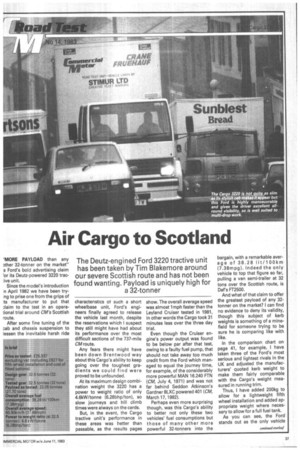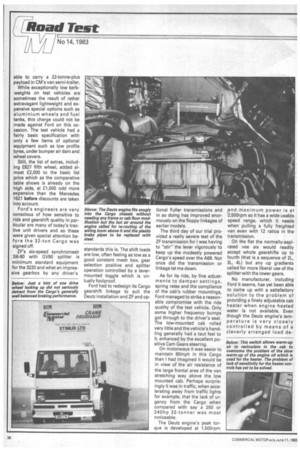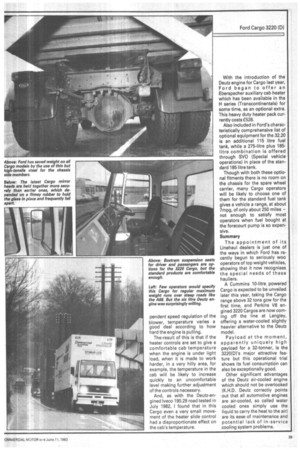Air Cargo to Scotland
Page 39

Page 40

Page 41

If you've noticed an error in this article please click here to report it so we can fix it.
'MORE PAYLOAD than any yther 32-tonner on the market" s Ford's bold advertising claim or its Deutz-powered 3220 tracive unit.
Since the model's introduction n April 1982 we have been tryrig to prise one from the grips of ts manufacturer to put that laim to the test in an operalional trial around CM's Scottish route.
After some fine tuning of the :,.ab and chassis suspension to lessen the inevitable harsh ride characteristics at such a short wheelbase unit, Ford's engineers finally agreed to release the vehicle last month, despite the reservations which I suspect they still might have had about its performance over the most difficult sections of the 737-mile CM route.
Any fears there might have been down Brentwood way about this Cargo's ability to keep going over the toughest gradients we could find were proved to be unfounded.
At its maximum design combination weight the 3220 has a power to weight ratio of only 4.6kW/tonne (6.28bhp/ton), so slow journeys and hill climb times were always on the cards.
But, in the event, the Cargo tractive unit's performance in these areas was better than passable, as the results pages show. The overall average speed was almost 1mph faster than the Leyland Cruiser tested in 1981, in other words the Cargo took 31 minutes less over the three day trial.
Even though the Cruiser engine's power output was found to be below par after that test, owing to a faulty fuel pump, that should not take away too much credit from the Ford which managed to equal the journey time, for example, of the considerably more powerful MAN 16.240 FTN (CM, July 4, 1971) and was not far behind Seddon Atkinson's Gardner 8LXC powered 401 (CM, March 17, 1982).
Perhaps even more surprising though, was this Cargo's ability to better not only these two vehicles' fuel consumptions but those of many other more powerful 32-tanners into the bargain, with a remarkable average of 38.28 lit/100km (7.38mpg). Indeed the only vehicle to top that figure so far, pulling a van semi-trailer at 32 tons over the Scottish route, is Daf's FT2500.
And what of that claim to offer the greatest payload of any 32tanner on the market? I can find no evidence to deny its validity, though this subject of kerb weights is something of a minefield for someone trying to be sure he is comparing like with like.
In the comparison chart on page 41, for example, I have taken three of the Ford's most serious and lightest rivals in the UK and adjusted the manufacturers' quoted kerb weight to make them fairly comparable with the Cargo's weight measured in running trim.
Thus, I have added 200kg to allow for a lightweight fifth wheel installation and added appropriate weight where necessary to allowfor a full fuel tank. As you can see, the Ford stands out as the only vehicle able to carry a 22-tonne-plus payload in CM's van semi-trailer.
While exceptionally low kerbweights on test vehicles are sometimes the result of rather extravagant lightweight and expensive special options such as aluminium wheels and fuel tanks, this charge could not be made against Ford on this occasion. The test vehicle had a fairly basic specification with only a few items of optional equipment such as low profile tyres, under bumper air dam and wheel covers.
Still, the list of extras, including £827 fifth wheel, added almost £2,000 to the basic list price which as the comparative table shows is already on the high side, at £1,500 odd more expensive than the Mercedes 1621 before discounts are taken into account.
Ford's engineers are very conscious of how sensitive to ride and gearshift quality in particular are many of today's tractive unit drivers and so these were given special attention before the 32-ton Cargo was signed off.
ZF's six-speed synchromesh S6-80 with GV80 splitter is minimum standard equipment for the 3220 and what an impressive gearbox by any driver's standards this is. The shift loads are low, often feeling as low as a good constant mesh box, gear selection positive and splitter operation controlled by a levermounted toggle which is virtually foolproof.
Ford had to redesign its Cargo gearshift linkage to suit the Deutz installation and 2F and op tional Fuller transmissions and in so doing has improved enormously on the floppy linkages of earlier models.
The third day of our trial provided a really severe test of the ZF transmission for I was having to "stir" the lever vigorously to keep up the modestly powered Cargo's speed over the A68. Not once did the transmission or linkage let me down.
As for its ride, by fine adjustments to damper settings, spring rates and the compliance of the cab's rubber mountings, Ford managed to strike a reasonable compromise with the ride quality of the test vehicle. Only some higher frequency bumps got through to the driver's seat. The low-mounted cab rolled very little and the vehicle's handling generally had a taut feel to it, enhanced by the excellent positive Cam Gears steering.
On motorways it was easier to maintain 60mph in this Cargo than I had imagined it would be in view of the air resistance of the large frontal area of the van stretching way above the low mounted cab. Perhaps surprisingly it was in traffic, when accelerating away from traffic lights for example, that the lack of urgency from the Cargo when compared with say a 250 or 240hp 32-tonner was most noticeable.
The Deutz engine's peak torque is developed at 1,500rpm ond maximum power is at 2,500rpm so it has a wide usable speed range, which it needs when pulling a fully freighted van even with 12 ratios in the transmission.
On the flat the normally-aspirated vee six would readily accept whole gearshifts up to fourth (that is a sequence of 2L, 3L, 4L) but any up gradients called for more liberal use of the splitter with the lower gears.
No manufacturer, including Ford it seems, has yet been able to come up with a satisfactory solution to the problem of providing a finely adjustable cab heater when engine heated water is not available. Even though the Deutz engine's temperature is very closely controlled by means of a cleverly arranged load de
Left: Few operators would specify this Cargo for regular maximum weight runs over steep roads like the A68. But the six litre Deutz engine was surprisingly willing.
pendent speed regulation of the blower, temperature varies a good deal according to how hard the engine is pulling.
Thea-esult of this is that if the heater controls are set to give a comfortable cab temperature when the engine is under light load, when it is made to work harder, in a very hilly area, for example, the temperature in the cab will be likely to increase quickly to an uncomfortable level making further adjustment of the controls necessary.
And, as with the Deutz-engined lveco 190.29 road tested in July 1982, I found that in this Cargo even a very small movement of the heater slide control had a disproportionate effect on the cab's temperature. With the introduction of the Deutz engine for Cargo last year, Ford began to offer an Eberspacher auxiliary cab heater which has been available in the H series (Transcontinentals) for some time, as an optional extra. This heavy duty heater pack currently costs £528.
Also included in Ford's characteristically comprehensive list of optional equipment for the 32.20 is an additional 115 litre fuel tank, while a 275-litre plus 185litre combination is offered through SVO (Special vehicle operations) in place of the standard 185 litre tank.
Though with both these optional fitments there is no room on the chassis for the spare wheel carrier, many Cargo operators will be likely to choose one of them for the standard fuel tank gives a vehicle a range, at about 7mpg, of only about 250 miles — not enough to satisfy most operators when fuel bought at the forecourt pump is so expensive.
Summary The appointment of its Linehaul dealers is just one of the ways in which Ford has recently begun to seriously woo operators of top weight vehicles, showing that it now recognises the special needs of these hauliers.
A Cummins 10-litre. powered Cargo is expected to be unveiled later this year, taking the Cargo range above 32 tons gcw for the first time, and Perkins V8 engined 3220 Cargos are now coming off the line at Langley, offering a water-cooled slightly heavier alternative to the Deutz model.
Payload at the moment, apparently uniquely high payload for a 32-tonner, is the 3220(D)'s major attractive feature but this operational trial shows its fuel consumption can also be exceptionally good.
Other significant advantages of the Deutz air-cooled engine which should not be overlooked (K.H.D. Deutz correctly points out that all automotive engines are air-cooled, so called water cooled ones simply use the liquid to carry the heat to the air) are its ease of maintenance and potential lack of in-service cooling system problems.
































































































